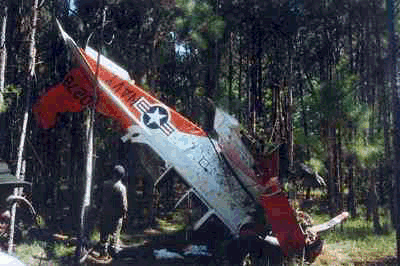WHAT TO
EXPECT WHEN YOU GET THERE
Editor's Note: this article originally appeared as "Danger In The
Dirt," in the March 1999 US Naval Aviation Safety Magazine "Approach."
Written by LCdr Dave Clark, USN
There will always be hazards around mishap sites. They will not always
be obvious and can sneak up and bite you when you're least prepared.
WE'RE ALL FAMILIAR WITH THE HAZARDS
that cause mishaps; much less attention gets paid to the hazards that result
from mishaps. People have had their fingers sliced and tendons cut. Vehicles
have bounded down mountains—fortunately, without drivers—and investigators
have been hurt while descending a precipice. Near-misses by rattlesnakes,
black widow spiders, and other creatures hiding in wreckage are all too
common. No one wants to take part in a mishap investigation, but when your
turn comes, here are some things to look out for.
DIRT, DUST AND PLANE BITS
People working at the site of a mishap are often immersed in charred
aircraft remains, the worst of which are composite fibers. Easily carried by
a breeze or stirred up by footsteps, tiny, black slivers of composite can
easily become imbedded in exposed skin. Constant scratching and annoying
skin pricks with your every move are sure signs you've got a problem. Be
smart around the wreckage. Long-sleeve shirts, or respirators and goggles
will keep these particles out of you and, most importantly, out of your eyes
and lungs. Reclamation teams and permanent mishap-board members who will be
the most exposed, must wear respirators and be respirator-qualified. A
little trick for those who must work with charred composites: talcum powder
and a silk stocking will remove fibers. Just sprinkle the powder on the
affected skin and rub it gently with until the fiber is snagged. It's as
simple as that, but it often needn't get that far. A good preventative
measure against fiber annoyance is a wet rag around the neck; this keeps the
fibers from going down your back. The benefits of this technique will be
immediately obvious.
 THINGS THAT GO BANG
THINGS THAT GO BANG
Watch out for Cartridge-actuated devices (CADs), tires, fire and oxygen
bottles, and especially unexpended ordnance. EOD teams must safe the site
and all components before anyone sifts through the wreckage. Particularly,
look out for charged bottles and detonation cord. They will be unstable and
need the attention of experts.
STUFF THAT CAN GO WOOSH AND HURT THE ENVIRONMENT
We're talking about fuel and oils, and just because you don't smell them,
don't think they’re not around. There was no fuel spilled when this T-34C
impacted the ground or while the aircraft was in the inverted position.
The fuel cell could not be de-fueled. When the aircraft was righted,
nearly 30 gallons of fuel spilled out of a tear. Use absorbent pads as soon
as possible to soak up what you can. The area may be extremely volatile
with fumes and standing fuel. Forget most everything else for the moment;
the ill effects of smoking, torches, or spark producing saws should have
your immediate attention. Be assured that all appropriate hazardous material
(HAZMAT) agencies will visit your site to assess environmental damage and
suggest cleanup methods. Value and utilize their expertise.
LOCATION, LOCATION, LOCATION
There's no good location for a mishap, but some are worse than others.
Mountains, bogs and deserts have their own distinctive hazards. Weather,
terrain and accessibility, and indigenous critters are but a few. Dress for
the location and the job. Tennis shoes and sweat pants won’t often work.
Keep in mind that a site’s remoteness will increase the time required to
transport injured site workers to a medical facility, so outfit your working
party for the environment.
LCdr. Clark is an aircraft-mishap investigator with the Naval Safety
Center Check the Naval Safety Center's web site for more information on
mishap-investigation tools and techniques via this site's
LINKS